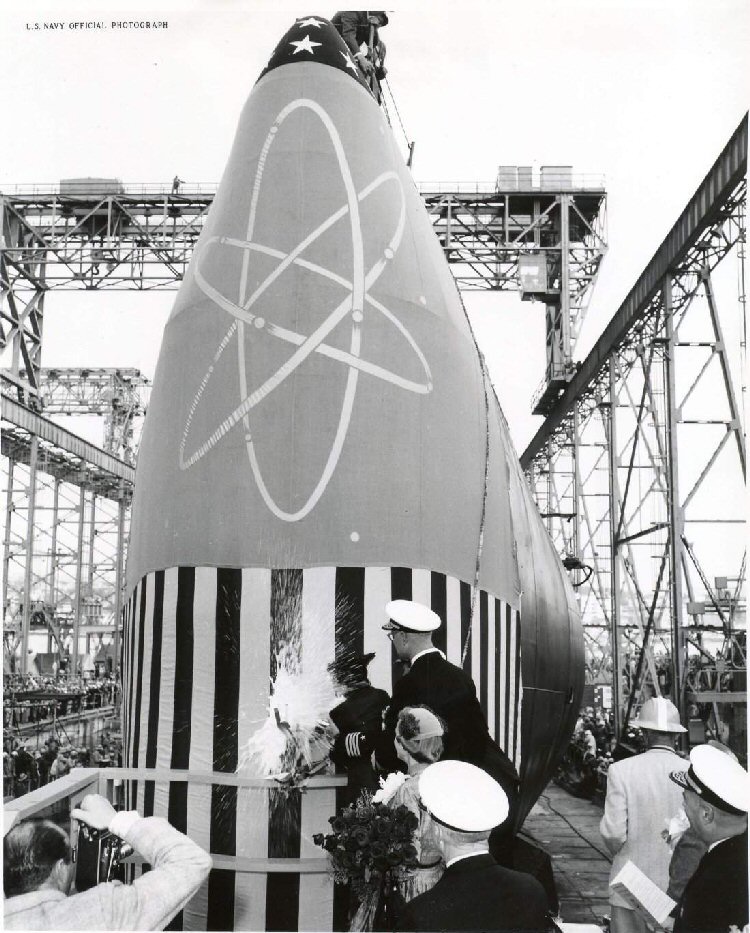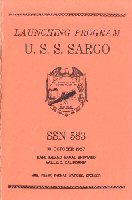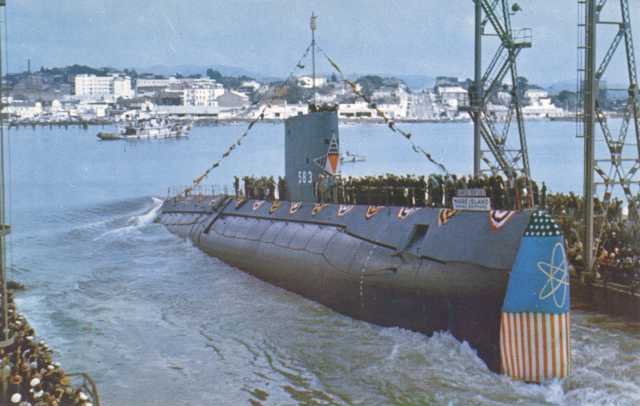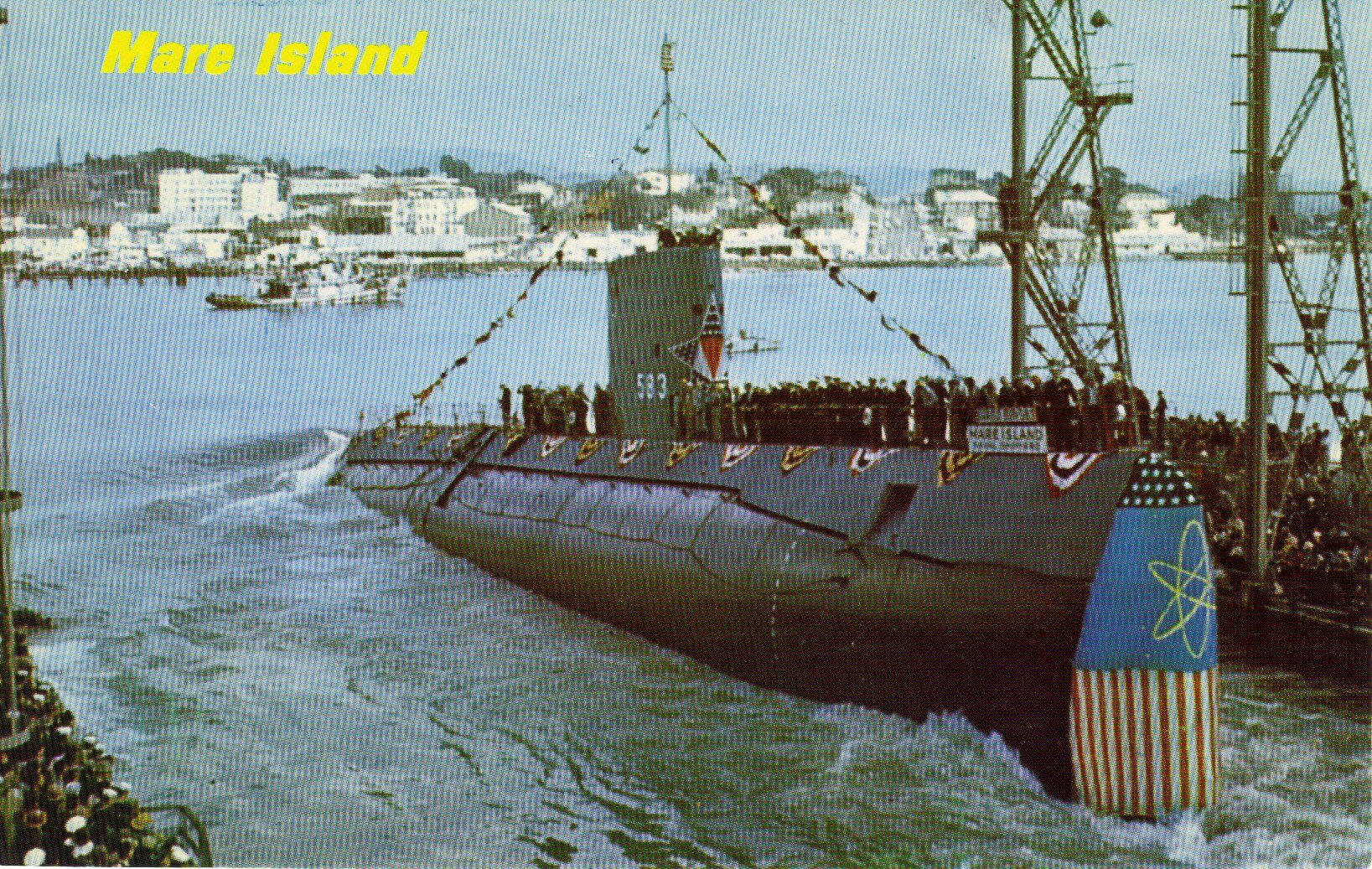
1957

|
USS SARGO (SSN 583)
1957 |

Click on the pictures to enlarge!

| "L" "V" Randolph, RMC(SS)(1957-1959) recalls: |
|
"I believe all of the non-rated commissioning crewmembers were involuntarily
drafted from various submarine squadrons. Most of them were like me in that they
never heard of SARGO before getting a set of orders to report ASAP.
"I know that I was very happy onboard USS CAPITAINE (SS 336) in San Diego when a set of orders came in for me. I remember the CAPITAINE's X.O. telling me to pack my bag for I was to be transferred immediately to report ASAP to the USS SARGO in Mare Island Naval Shipyard. "Can you imagine what life was like for us few non-rated sailors with more than fifty first and second class Petty Officers over us? "I believe, according to Chief Niccum and SN Santmeyers that in October of 1958 Chief Leroy Ingles, the COB, was the oldest crewmember and I was the youngest crewmember. They wanted Chief Ingles and me to ring the ship's bell the following January 1, 1959. The event did not happen because Chief Ingles had other commitments." |

CONTINUED CONSTRUCTION

CHRISTENING CEREMONY AND LAUNCHING
| The launching of the USS SARGO took place at Mare Island Naval Shipyard, Vallejo, California on 10 Oct 1957. Reading from the ship’s Launching Program (provided courtesy Frank Munroe) the ceremony and the ship were described as follows: |
|
The submarine SARGO which is being launched today is the first nuclear-powered submarine built on the West Coast. The SARGO is also the fifth nuclear-powered submarine in the history of the United States Navy and will be propelled by a water-cooled reactor similar to that pioneered in USS NAUTILUS. This type of propulsion will result in increased underwater speed and a submerged endurance limited only by human frailties. SARGO’S design also incorporated increased maneuverability and operating depth. She carries recent advances in electronic and fire control equipment, improved torpedo tubes. With her nuclear propulsion plant coupled with these characteristics, SARGO is well equipped to accomplish her mission: Seek out and destroy the enemy! SARGO is the 20th submarine and 495th craft built in the Mare Island Naval Shipyard during its 103 year history. The SPONSOR: Mrs. Frank T. Watkins (nee Margaret Orem) is the wife of Vice Admiral Watkins, USN, and a native of Salt Lake City, Utah. She attended Mills College in Berkeley, California, and graduated from the University of Southern California. In 1925 she married the then Lieutenant (jg) Frank T. Watkins, USN, and accompanied him to New London, Connecticut, where her husband entered the Submarine School and commenced his long career in the submarine service. They have two sons, both married, and four grandchildren. The older son, Lieutenant F. T. Watkins, Jr., USN, is also a submarine officer and is currently a student at the U. S. Naval Postgraduate School, Monterey, California. The younger son, John O. Watkins, is an employee of the Hewlett Packard Electronics Corporation, Palo Alto, California. Mrs. Watkins’ daughter-in-law, wife of Lieutenant F. T. Watkins, Jr., USN, will be Matron of Honor to the Sponsor. The SPEAKER: Vice Admiral Frank T. Watkins, USN, is the Commander Anti-submarine Defense Force, U. S. Atlantic Fleet, and Commander U. S. and Ocean Sub-Area, Atlantic, North Atlantic Treaty Organization (NATO). He is a native of Salt Lake City, Utah, and a graduate of the U. S. Naval Academy, Class 1922. Since 1925 most of his assignments both at sea and ashore have been in or in connection with submarines. From 1934 to 1936 he served as Submarine Planning and Ship Superintendent at Mare Island Naval Shipyard. In 1947 he organized and became the first Commanding Officer of the U. S. Naval Schools, Monterey, California. He has been commanding officer of several submarines, was a Submarine Division Commander during the war, and later became Chief of Staff, Submarines, Pacific. More recently (1954-1957), he was Commander Submarine Force, U. S. Atlantic Fleet, during which time the USS NAUTILUS, the first nuclear powered submarine joined the fleet and was assigned to his operational control for the first two years of her duty with the fleet. |
 Courtesy Darryl L. Baker
Courtesy Darryl L. Baker
|
|
Mrs. F. T. Watkins (Sponsor) christens the USS SARGO (SSN 583) on 10 Oct 1957.
[U.S. Navy Photo NY9 36995-10-57] |
| A Vallejo Times-Herald newspaper article marked the occasion: |
|
By FRANCIS FLAHERTY
The $48,000,000 submarine Sargo, whose next cruise of any distance will be
made on nuclear power, required only a well-greased path and the pull of
gravity yesterday afternoon to make her maiden immersion a smooth-as-silk
success before the eyes of 10,000 enthusiastic viewers, including two assistant
Navy secretaries, at Mare Island Naval Shipyard.
The Pacific’s first atomic submarine, whose bulk on the ways was announced at
2,150 tons, faltered not even an instant when the launch trigger was pulled,
permitting her to go forth to her natural habitat – the sea. And she must have
been given at least some impetus on her waterward journey by the resounding
smash Mrs. Frank T. Watkins, Sr., her sponsor, delivered across her bow with
a metal encased champagne bottle.
Her performance and that of the Sargo were greeted by a crescendo of applause
from the crowd. Rousing cheers were raised by the two top Navy aides, Assistant
Secretaries Fred A. Bantz and J. Sinclair Armstrong, who among the hundreds of
distinguished guests, both military and civilian, attending the colorful
spectacle.
Mrs. Watkins’ prowess as a hitter was well advertised in advance of her
deed by her husband, Vice Admiral Frank T. Watkins, Sr., who departed from the
text of his launching address to confide to the crowd how his wife had prepared
her self for her big moment.
"Mrs. Watkins left our home in the East, for Mare Island ahead of me," the
admiral said, obviously enjoying his story-telling role, "because I was on duty
as commander of the Anti-Submarine Defense Force in the Atlantic.
"When I arrived home and was making ready to follow her here, I came across a
baseball bat in the house. I asked my steward what it was doing there, and he
answered that it was Mrs. Watkins’ property, further volunteering the
information that she had been spending no little time perfecting her swing
by belting an old tree in our back yard.
"Now, I want to tell you people," the admiral continued, his eyes twinkling as
he spoke, "that I hope Captain Fahy has built additional strength into the bow
of this ship because I am sure this bottle is going to get a swing that would
do credit to Mickey Mantle."
AT THE appointed instant, 1:27 p.m., Mrs. Watkins swinging from the
left side, came around with a mighty wallop as the ship moved away from the
launching platform.
The ensuing roar, a deafening cacophony of cheers, music, whistles, sirens
and bells apparently left Mrs. Watkins so shaken that she was unable,
momentarily at least, to recite the vital phrase: "In the name of the United
States of America, I christen thee Sargo." But she recovered in time to shout
the christening words before the stern of the boat met the water of Mare Island
Channel.
Rain, which had threatened to mar the historic occasion, graciously failed to
materialize.
Instead, the sun played peek-a-boo over the scene throughout the ceremony,
sporadically breaking through rifts in the cloud bank overhead to bathe the
ship and assemblage with mildly warm rays.
The launching was immediately preceded by a moment of prayer, in which Comdr.
James S. Ferris, (ChC), USN, base chaplain, prayed: "Great God of love, in the
great strides we are taking, may we never lose sight of our dependence on Thee ..."
Capt. E. J. Fahy, USN, shipyard production officer who served as officer in charge
of the launch, explained to the vast gathering well in advance that the trigger
would be released early.
HE SAID that the brief time when high tide and slack current would coincide
would be ahead of earlier computations. It was for that reason that the Sargo
departed the ways three minutes earlier than the 1:30 hour originally announced
as the launching time.
The program began with the impressive "Champagne Walk," to which the launching
party made its way to the speakers platform. Mrs. Watkins walked up on the arm
of Rear Adm. Martin J. Lawrence, USN, Mare Island Naval Shipyard commander and
her daughter-in-law matron-of-honor, Mrs. Frank T. Watkins, Jr., was escorted
by her father-in-law, Admiral Watkins.
Admiral Lawrence, as master of ceremonies, introduced as guest speaker Vice Adm.
John R. Redman, USN, recently retired commandant of the 12th Naval District, who
was principal speaker when the Sargo's keel was laid.
ADMIRAL REDMAN recalled the earlier even in his brief remarks when he said:
"To see the culmination of that event
also delivered a message from Adm. Felix B. Stump, USN, commander-in-chief of the Pacific Fleet. "IT IS VERY appropriate," Admiral Grenfell told his listeners, "that this, the Mare Island Naval Shipyard, long a submarine building yard of great reputation, has the honor of building the first nuclear submarine west of the Mississippi. We in the Submarine Force, Pacific, will long remember the great names of fine submarines built here in years gone by - submarines such as Seahorse, Silversides, Trigger, Gudgeon, Tunny and many others that were born in yard. I am sure that the Sargo will likewise continue to prove that Mare Island officers, men and women, have again built a wonderful submarine - this one a submarine of the new Atomic Era." From Admiral Stump, Grenfell brought this message: "Today, October 10, is a most significant date, marking the occasion of the launching of the Sargo, the first nuclear-powered ship ever constructed on the West Coast. This event demonstrates a clear manifestation of the ability of the naval shore establishment in this area to build the highly specialized ships required by the Pacific Fleet to carry out its objectives ..." "The Sargo is proof of the West Coast's nuclear shipbuilding capability, and indicates that in the near future, we in the Pacific will no longer be required to rely solely on the industrial centers of the east for the design, construction and logistic support for ships of our nuclear Navy." ADMIRAL LAWRENCE then read a message from Rear Adm. Hyman G. Rickover, USN, "father" of the nuclear-powered Navy, in which he said: "I regret that circumstances prevent me from being present at the Sargo launching. The early and successful completion of this ship is important to the defense of the United States. Please give my best wishes to all the men and women of Mare Island Naval Shipyard for the ultimate success of their undertaking." In the only other departure from the prepared text of his address, Admiral Watkins introduced Lieut. Comdr. Daniel P. Brooks, who will be the skipper of the ship to the atomic sub to join the Pacific Sub Force, the two other now on active duty having been assigned to the Atlantic Fleet. The Sargo is the fifth N-submarine to have been launched, preceded by the Nautilus, Seawolf, Skate and Swordfish. Three other nuclear subs are either under construction or being designed for construction at Mare Island. On the building ways to the north of Sargo platform, almost obscured to the throngs, lay the Halibut, first nuclear guided-missile launching submarine ever to be constructed. The Sargo is slimmer and shorter than the Nautilus. Her reactor, built by Westinghouse Electric Corp., is of the same design as that for the Nautilus, but contains a number of unrevealed advances. Presiding over the trigger at the launching was Lieut. William Bass, USN, who was ship superintendent for the Sargo during most of her time on the ways. THE SARGO picked up speed to a top of 22 miles per hour then slowed to 17 as her propellers surged against the water. Huge piles of "chain drags" halter her forward progress after about 300 feet, and she was taken in tow by yard tugs, which moved her north of the guided-missile launcher Grayback, a conventionally-powered sub that went down the ways July 2. The impressive ceremonies were given a high sheen by a snappy Marine Color Guard and by fine martial music played by the 12th Naval District Band. On the speakers platform besides the principals in the launching were: Rear Adm. and Mrs. G. L. Russell, USN; Maj. Gen. and Mrs. G. F. Goode, USMC; Rear Adm. and Mrs. William V. O'Regan, USN; Maj. Gen and Mrs. Hugh A. Parker, USAF; Rear Adm. and Mrs. W. L. Erdmann, USN; Col. and Mrs. J. Paul Lawther, USA. Distinguished guests introduced by Admiral Lawrence included Rep. and Mrs. John F. Baldwin, Jr.; Rep. and Mrs. William S. Maillard; State Sen. and Mrs. Luther E. Gibson; State Sen. and Mrs. E. D. Desmond; State Sen. and Mrs. Robert L. McCarthy; Assemblyman and Mrs. Sam Geddes, and Assemblyman H. W. Kelly.
|
|
“Now, I want to tell you people," the admiral continued, his eyes twinkling
as he spoke, "that I hope Captain Fahy has built additional strength into the
bow of this ship because I am quite sure this bottle is going to get a swing
that would do credit to Mickey Mantle."
Laughter and applause greeted the admiral’s remarks, but it developed he was an apt prophet. At the appointed instant, 1:27 p.m., Mrs. Watkins, swinging from the left side, came around with a mighty wallop as the ship moved away from the launching platform. The Submarine being launched today is the second United States Navy Submarine to bear the name SARGO. The first SARGO was built by Electric Boat Company, Groton, Connecticut and commissioned on November 7, 1939. This earlier SARGO was in Philippine waters on December 7, 1941 and made its first attack with torpedoes seven days later. During its second patrol it carried out a special mission which included the delivery of one million rounds of 30 caliber ammunition to various Philippine destinations and brought out 24 American soldiers. During several patrols it sank seven enemy vessels for a total of 32,777 tons. Following V-J Day the earlier SARGO was stricken from the Navy Register and was scrapped. |
 Courtesy Frank Munroe
Courtesy Frank Munroe
|
 Courtesy Frank Munroe
Courtesy Frank Munroe
|
|
| A copy of the Launching Program for USS SARGO (SSN 583). | ||
 Courtesy Michael Hacking
Courtesy Michael Hacking
|
 Courtesy Michael Hacking
Courtesy Michael Hacking
|
|
| Postcard pictures of USS SARGO (SSN 583) sliding down the ways into the Napa River. | ||
